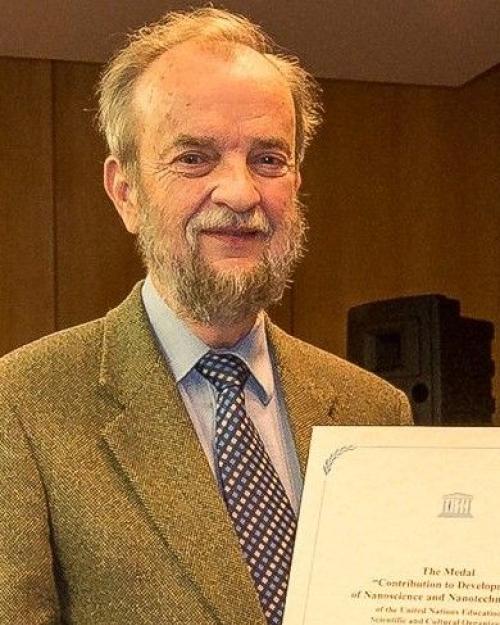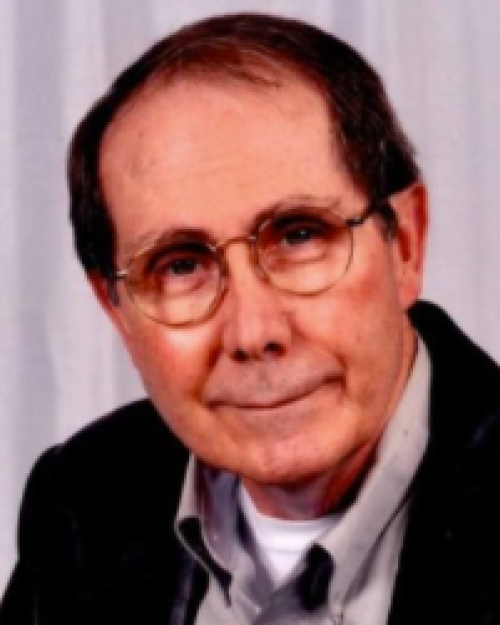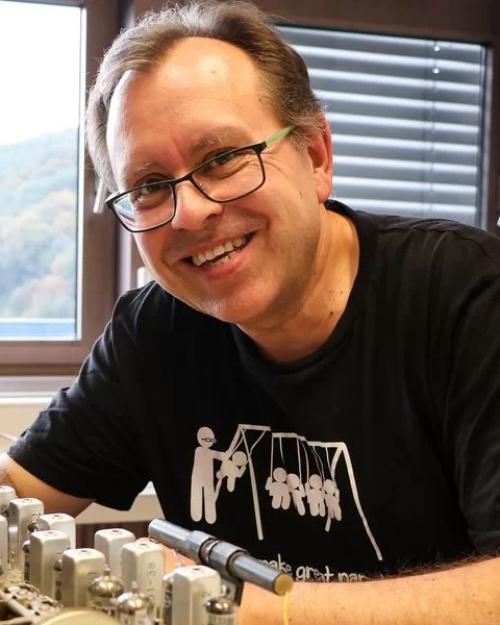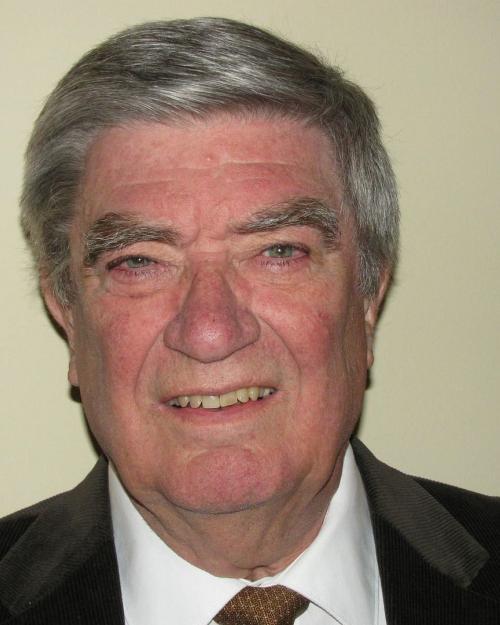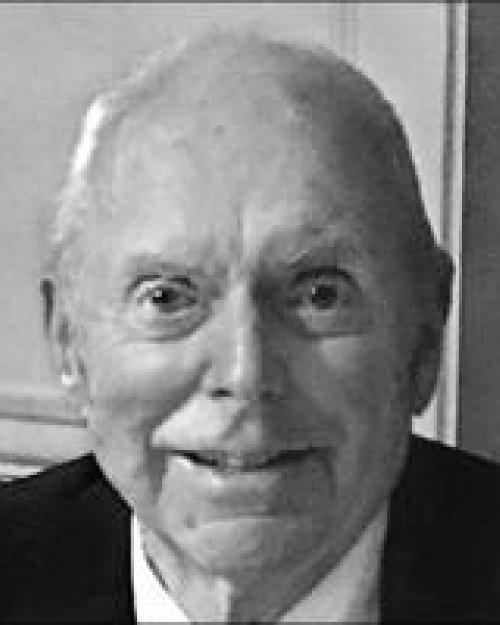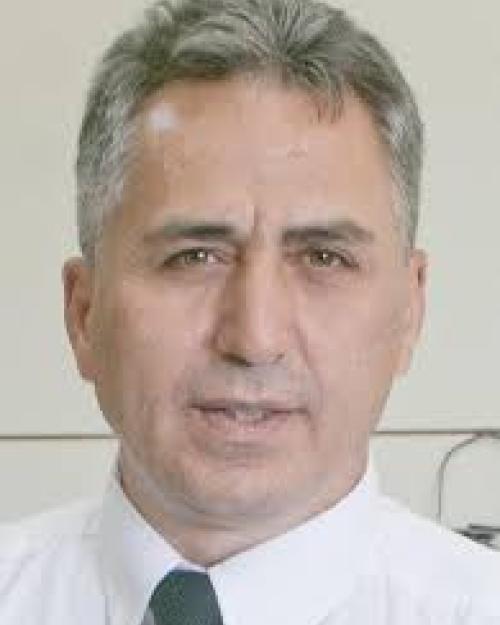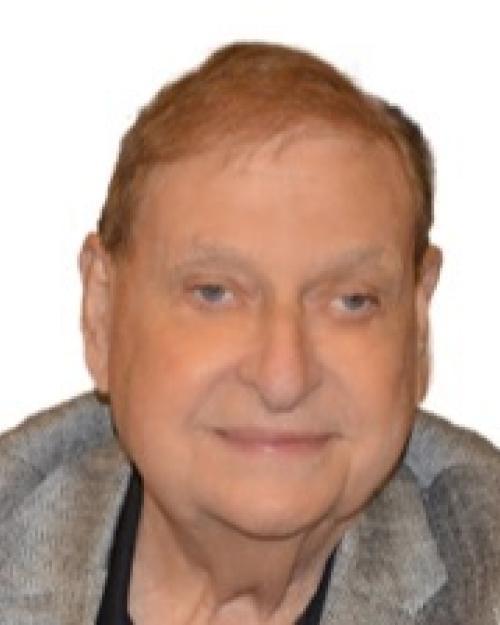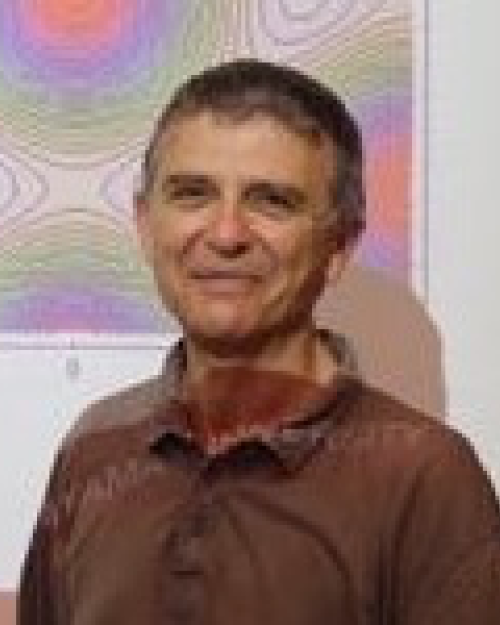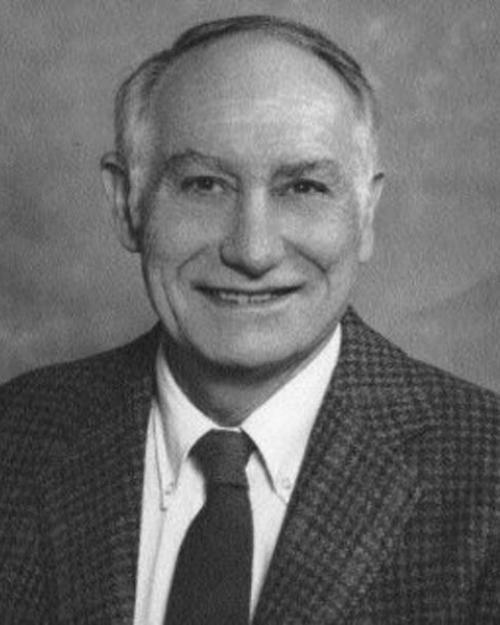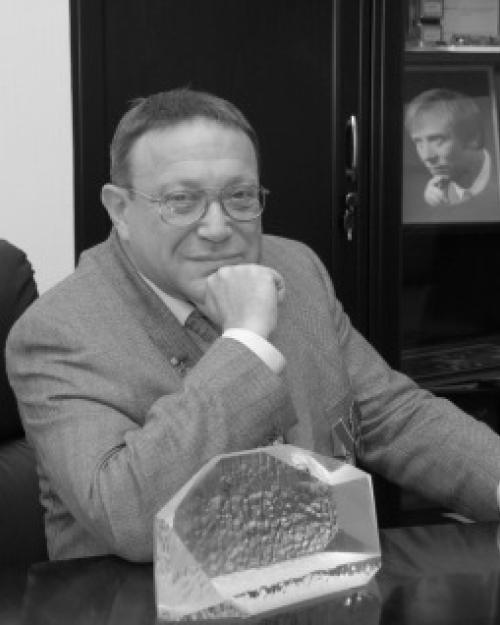-

James F. Scott
-The international Ferroelectrics community lost one of its most outstanding members with the passing of Professor Jim Scott on 6 April 2020. Jim served as a faculty member of five prestigious universities and received many international awards. His numerous publications have received more than 50,000 citations. James F. Scott was born in New Jersey, USA, and educated at Harvard (B. A., physics 1963) and Ohio State University (Ph.D., physics 1966). After six years in the Quantum Electronics Research Department at Bell Labs he was appointed professor of physics at Univ. Colorado (Boulder), where he also served as Assistant Vice Chancellor for Research. He was Dean of Science and Professor of Physics for eight years in Australia (UNSW, Sydney, and RMIT, Melbourne), Professor of Ferroics in the Physics Department at Cambridge University, and since 2015 Professor of Chemistry and Physics at Univ. St. Andrews. His paper “Ferroelectric Memories” in Science (1989) is probably the most cited paper in electronic ceramics with 4000+ citations, and his textbook of the same title has been translated into Japanese and Chinese. He was elected a Fellow of the APS in 1974, and in 1997 won a Humboldt Prize and appointment as the SONY Corp. Chair of Science (Yokohama). He was awarded a Monkasho Prize in 2001 and in 2008 was elected a Fellow of the Royal Society (FRS) and recipient of the MRS Medal (Materials Research Society). In 2011 he was elected to the Slovenian Academy of Sciences where earlier he had won the Jozef Stefan Gold Medal. In 2014 he won the Thomson-Reuters Citation Laureate prize, which describes itself as a predictor of Nobel Prizes in Physics, and in 2016 received the UNESCO medal for Contributions to Nanoscience and Nanotechnology. His work has been cited 50,000 times in scientific journals, with eight papers each cited more than 1,000 times and a Hirsch h-index of 100. Additional information about Jim Scott’s life can be found at https://ethw.org/Oral-History:James_F._Scott

Ronald Beard
-Ronald (Ron) Beard, 76, passed away July 20, 2020. He is survived by his wife of 54 years, Carol Ann Beard; his son, Orson Beard (fiancé Melissa); grandchildren, Zachary, Kyle and Elizabeth; and his half-brother, Terry. He is preceded in death by his son, Gregory. Ronald Beard was a physicist at the U.S. Naval Research Laboratory (NRL). He held undergraduate degrees in Chemical Engineering and Physics and a graduate degree from George Washington University. He began his professional career as an officer in the U.S. Navy in 1968. He retired from full-time government service in 2015, but continued to work part-time at NRL until the time of his death. Mr. Beard’s most notable contribution was as a pioneer in the design and development of technologies for the Global Positioning System (GPS), an essential and ubiquitous capability used all over the world. He continued supporting the operation of GPS and the development of improvements to it. His work also included the expansion of the basic capabilities of GPS into precise frequency and time of day distribution for communications, business, and scientific research. As a young naval officer, Ron was the Project Officer for Navigation Satellites in the Naval Air Systems Command’s Astronautics Division and the TIMATION program, a forerunner to GPS. In 1971 he joined the NRL and their early GPS developments (1971-1979) as the project scientist in the NRL’s GPS Program Office which developed Navigation Technology Satellites One and Two and operated the first atomic clocks in space. In succeeding years, he was the Program Manager of the NRL NAVSTAR GPS Clock Development Program that developed alternative sources of space qualified atomic clocks for the GPS program. One of the primary and most critical contributions of NRL to the GPS program were the development of technologies for enabling space qualified atomic clocks. Those developments began in the early days of GPS and continued under Mr. Beard’s leadership when he became the head of the Space Applications Branch in 1984. Under his leadership that technology came to fruition in the Rubidium technology used in the operational GPS satellites of today. Ron was also instrumental in the development of NRL’s unique capability to test these units under operationally space–like conditions, a capability still used today to test and validate GPS space clocks. Mr. Beard has participated in numerous technical groups including the Air Force Scientific Advisory Board Study Group into Global Air Navigation, Navy representative on Project Reliance Frequency Control Panel, Head of the DoD PNT Focus Team for Space Technology. He has authored or co-authored over 50 technical papers. He was an organizer of the Joint Navigation Conference (JNC) as part of the Institute of Navigation (ION), and served as a Government Liaison to the ION’s Military Division. He was a Fellow of the Institute of Navigation and an ION member for over 30 years. He was also a member of the annual Precise Time and Time Interval (PTTI) Executive Committee, where he served in several executive positions and received the Distinguished PTTI Service Award in 2012. He was a member of the American Geophysical Union and a Senior Member of the American Institute of Aeronautics and Astronautics. Mr. Beard has participated in or chaired numerous committees dealing with Precise Time and Frequency that have determined the course of systems and technology development both nationally and internationally. He has been the International chairman of the ITU-R working party on Precise Time and Frequency Services since 2005 that determines recommendations to the international community on the generation, dissemination and evaluation of precise time and frequency systems. As the chairman he has participated not only in ITU-R workshops, seminars and working groups but also has represented the ITU and the U.S. in international committees that determine the international time scale and dissemination services.

Siegfried Bauer
-Siegfried Bauer, an internationally renowned, very creative applied physicist, who also was a prolific materials scientist and engineer, died on 30 December 2018 in Linz, Austria, after a one-year battle with cancer. He was full professor of soft-matter physics at the Johannes Kepler University Linz, Austria, and a scientific leader and innovator across the fields, but mainly in the areas of electro-active materials (including electrets) and of stretchable and imperceptible electronics. Siegfried Bauer was born on 15 May 1961 in the small village of Berghausen (Pfinztal) near Karlsruhe. He was the youngest son of a locksmith and a seamstress. His parents were also part-time farmers who owned a small plot of land including a vineyard. In the rural environment of his home village, he quickly develops a very open mind, curiosity about almost everything around him and a deep love of nature. During a long illness in his youth when he had to stay in a hospital bed for several months, he intensely studies mathematics and physics textbooks and subsequently becomes an excellent student. He was fortunate to find deep inspiration and support in his physics teacher, who further motivates him so that he decides to study physics at the University of Karlsruhe (now Karlsruhe Institute of Technology or KIT) from 1980 until 1986. At his university, Siegfried quickly discovers some of the strange features of a traditional research and teaching institution and develops a critical attitude and a unique sense of humor about the academic establishment and its rituals. At the same time, however, he meets inspiring teachers and mentors who selflessly support and guide one of their most gifted students. Wolfgang Ruppel, full professor of applied physics, accepts him as Ph.D. student and encourages him to pursue his own research direction and to start working on ferroelectric polymers, which were at that time still quite often seen as an oddity or even considered “dirty physics” by the solid- state physics community. Siegfried Bauer kept very fond memories of Wolfgang Ruppel, recently stating he would still “go through thick and thin any day with his Ph.D. advisor”. In 1990, Siegfried Bauer successfully defends his Ph.D. thesis on ferroelectric polymers with the rare grade summa cum laude. He continues to work as post- doctoral scientist at his alma mater, but also starts to teach at the Fachhochschule Karlsruhe and takes up research projects at the universities of Karlsruhe, Marburg and Stuttgart in Southern Germany. His expertise in research and teaching grows quickly, and his seminal work leads to several publications. At this time, he also meets his future wife Simona Gogonea who arrives on a German Academic Exchange Service (DAAD) scholarship from Bucharest, Romania. Siegfried and Simona marry soon (in 1991) and become very close companions in life and science. In 1992, he joins the Heinrich Hertz Institute for Telecommunications (HHI) in Berlin- Charlottenburg as scientist and project manager. Within his team, he initiates and develops several new experimental techniques and achieves a large range of remarkable results that yield seminal publications mainly in the area of nonlinear optics and photonics with electrooptical polymers. For some of his excellent papers, Siegfried Bauer receives the Prize of the Information Technology Society (ITG) within the German VDE and the Kurt Ueberreiter Award of the Berlin-Brandenburg Society for Polymer Research (BVP), both in 1994. International collaborations take him to the École Polytechnique in Montréal, Québec, Canada (twice), to the University of Arizona in Tucson and to the National Institute of Standards and Technology (NIST) in Gaithersburg, Maryland, and lead to several joint publications. When his mentor and life-long friend Reimund Gerhard moves to the University of Potsdam at the end of 1994, Siegfried Bauer becomes his successor as team leader at the HHI. Later Siegfried follows him to the University of Potsdam in order to prepare for his habilitation, and Simona Bauer-Gogonea who in 1995 received her Ph.D. from the Technical University (TU) of Berlin takes over as team leader. Dr. Bauer’s very productive and successful years in Berlin and Potsdam culminate in his habilitation on “Poled polymers for applications in sensorics and photonics” which he defends in 1996 at the University of Potsdam. In 1997, he receives the prestigious Karl Scheel Award of the Physikalische Gesellschaft zu Berlin (PGzB) within the German Physical Society (DPG). After his appointment as lecturer (Privat-Dozent) at the University of Potsdam, he receives offers from a number of universities and accepts a position as Associate Professor at the Johannes Kepler University (JKU) in Linz, Austria, where he starts in October 1997. In 2002, Siegfried Bauer is appointed full University Professor of Experimental Physics and establishes the department of Soft Matter Physics at his university. He soon becomes one of the most successful, most influential and most recognised scientific researchers and academic teachers at the JKU Linz. During more than 20 years in Linz, Siegfried Bauer further developed a unique style of research and teaching together with his team. His approach to science starts with open questions and includes unconventional or orthogonal “out-of-the-box” ways of thinking in a playful manner. In Siegfried’s view, occasional failure is not only taken into account, but is seen as a necessary condition for eventual success because we learn mainly from mistakes and failures – just like our children and our best students. The essence of Siegfried Bauer’s research and teaching “philosophy” is probably its focus on the human beings who are the actors of the scientific process, who enjoy to play and to develop like children, who need (and want) to exchange ideas and to work together, who naturally bring a rich diversity of talents and competences to the process, and who always need to overcome inherent restrictions from traditions, conventions, rulebooks, etc. Siegfried Bauer’s approach overcomes boundaries between disciplines, between theory and application, between different cultures and countries, between arts and sciences, between philosophy and engineering, and – last, but not least – between seriousness and playfulness. Maybe his style is best characterised with the words of Georg Christoph Lichtenberg who wrote around 1795: “The science of electricity is, along the common path, now so well trodden and scoured that nothing is to be gained anymore on the highway – one must march cross-country and leap over ditches. This method which one could well call unmethodical is, by the way, to be recommended very much indeed.”[1] Siegfried Bauer himself occasionally referred to Paul Feyerabend, the Austrian/US-American philosopher of science, and his book “Against Method: Outline of an Anarchist Theory of Knowledge” in 1975.[2] Given his unconventional approach, it was probably unavoidable that Siegfried Bauer sometimes caused anger and resistance among his scientific peers, since he questioned beloved certainties and authoritative conventions in a playful manner and often used Socratic probing in his thinking and teaching. And when he felt that creative, well-founded new approaches were ruled “nonsense”, he stepped in and defended the right to think differently and to err, as there is no absolute truth. Over the past two decades, the very original and highly creative “Bauer approach” yielded impressive successes and results in research and teaching within the Soft Matter Physics department at the JKU Linz. Only a few particularly noteworthy examples are mentioned in the following: With his foresight and insight, Siegfried Bauer significantly advanced the new field of polymer ferroelectrets that began in Finland and that he named and led to a lasting success story in research and engineering together with his peers all over the world. Siegfried Bauer’s new concepts and research in the area of flexible and stretchable polymer-based electronics led to fundamental advances and to the development of practical devices – sometimes in close collaboration with international partners. His team in Linz successfully demonstrated several essential steps to lead the way from “crazy ideas” to technically feasible applications. Siegfried made important contributions to a new way of thinking about active soft matter and its technical use. Starting from the notion that devices suitable for people should not disturb the user and should ideally not even be perceived by the user, Siegfried Bauer and his team – together with international partners – spearheaded the development of imperceptible and biocompatible electronics including sensors, actuators and displays. In this area, the research of the Linz group is very quickly adopted and successfully advanced by other teams all over the world, and it is sometimes underestimated how much the new field owes to Siegfried Bauer’s visionary and playful creativity. In his last paper just published in the American Journal of Physics, Siegfried and his team used a high-speed camera in the foyer of a high-rise university building to follow the fall of paper cones with high precision. From a critical assessment of the results, it is concluded that the philosophical differences between Aristotle and Galileo about falling objects disappear if the implicitly included conditions of each situation are explicitly taken into account. The underlying experiments and their careful analysis can be employed to teach about multiple possibilities of objects to fall in different situations. In this case, direct experimental evidence helps to develop a more precise physical thinking already in high schools and also later in universities. The unusual approach and the deep insight of Siegfried Bauer and his research team yielded not only many highly cited and internationally recognised publications, but led also to several awards and honors. Here, we only mention the awarding of a rare and prestigious Advanced Investigator Grant by the European Research Council (ERC) for Siegfried Bauer in 2011 and his appointments as fellow by the Institute of Electrical and Electronics Engineers (IEEE) for “contributions to the understanding and application of electroactive polymer dielectrics” and by the Society of Photo- Instrumentation Engineers (SPIE) for “achievements in plastic electronic devices and soft matter physics” in late 2015 and late 2018, respectively. As documented in his publications, Siegfried Bauer had many professional and personal friends and scientific collaborators all over the world – from Israel to Ireland, Canada to China, New Zealand to North America. He was an active contributor to several learned societies, to international conferences and to leading scientific and technical journals, e.g. as Associate Editor and Member of the Editorial Board of Applied Physics A (Springer), Applied Physics Review (AIP), Extreme Mechanics Letters (Elsevier), IEEE Transactions on Dielectrics and Electrical Insulation (IEEE DEIS), and Proceedings of the Royal Society A (The Royal Society); as member or co-chair of conference steering committees for the Conference on Electroactive Polymer Actuators and Devices (SPIE), the International Conference on Electromechanically Active Polymer Transducers and Artificial Muscles (EuroEAP Society), the International Symposium on Electrets (IEEE Dielectrics and Electrical Insulation Society), Symposia of the Materials Research Society (MRS), etc. In addition, Siegfried was in high demand as an experienced, polite and careful reviewer for several international journals and high-level funding agencies. The international scientific community and the Johannes Kepler University Linz have lost an unusual and unusually successful researcher and teacher, a beautiful mind and a very special person – and last, but not least a very good friend. Siegfried Bauer was a man full of curiosity; with a unique view on the wide world and on his environment; always keen to learn from every experience and even from his failures; a person who trusted his friends and colleagues as well as his own abilities, but who also knew his limitations; equipped with a skeptical, questioning attitude towards so- called authorities and established knowledge; with a great sense of humor that was sometimes very special, but never offensive; someone who enjoyed lateral thinking and finding unusual, but convincing solutions to any problem that interested him – and there were many scientific and non-scientific problems that attracted Siegfried’s searching mind. Siegfried is survived by his wife Simona, his daughter Lara, his son Lukas, his mother, and two of his brothers. His family, his friends and colleagues all over the world, his university, his former and present students, and others who knew him will tremendously miss Siegfried Bauer, but will always remember him as a very special person full of humor and empathy and as an inspiring and supporting companion and guide. His memory, his philosophy and his work will remain alive in and through all who met him. Reimund Gerhard, University of Potsdam and IEEE DEIS Martin Kaltenbrunner, Johannes Kepler University Linz Additional sources for information about Siegfried Bauer: https://scilog.fwf.ac.at/en/environment-and-technology/5076/only-those-… https://www.jku.at/en/institute-of-experimental-physics/soft-matter-phy… team/siegfried-bauer/ [1] – From the entry K384 in a scrap book (“Sudelbuch”) for 1793-1796 by Georg Christoph Lichtenberg. Original German text: “Die Lehre von der Elektrizität ist jetzt da, wo man gewöhnlich passiert, so abgetreten und abgesucht, dass an der Heerstraße nichts mehr zu gewinnen ist; man muss querfeldein marschieren und über die Gräben setzen. Diese Methode, die man wohl die unmethodische nennen könnte, ist überhaupt nebenher sehr zu empfehlen.” [2] – Published 1975 in London. German title: “Wider den Methodenzwang.” Suhrkamp, Frankfurt am Main 1976.

Herman van de Vaart
-
Robert Vessot
-VESSOT, Robert Frederick Charles Physicist Born April 16, 1930 in Montreal, Canada, Bob was the only child of Robert Charles Ulysses Vessot, and Marguerite Yvonne (Giauque) Vessot. Bob was raised in the Town of Mount Royal, and earned a B.A., M.Sc. and Ph.D. in Physics, from McGill University in Montreal. He served in The Royal Canadian Air Force with N.A.T.O. as Station Communications Officer in Zweibrucken, Germany. In 1956 Bob settled in Cambridge, MA having been recruited by M.I.T. as a post doctorate member of the research staff working on the development of the Hydrogen Maser (Atomic Clock), invented by two Nobel Prize winners at Harvard. It was during this time that he met and married his wife of 59 years, Norma (Wight), another transplant from Montreal to the Boston area. In 1960 he moved his young family to Marblehead and went to work at Varian Associates in Beverly, MA. When Bob elected not to relocate to California upon his company’s acquisition by Hewlett-Packard, Bill Hewlett personally facilitated the move of his entire lab to the Harvard Center for Astrophysics in Cambridge, MA. He worked as a physicist at the Smithsonian Astrophysical Observatory and as an associate of the Harvard College Observatory until his official retirement in 2001, although he continued volunteering with graduate students at the lab until 2015. Over the course of his successful career, Bob was best known for his contributions to the development of the atomic clock based on the maser and its application to the experimental verification of Einstein’s General Theory of Relativity, which he performed with NASA. For this he was awarded the NASA Medal for Exceptional Scientific Achievement in 1978. The 30 atomic clocks built by his group have been used in satellite-tracking stations, in radio telescopes, in research labs in the United States and Europe, by the U.S. Naval Observatory for tracking the Nation’s time, and by Jet Propulsion Labs to guide the Voyager spacecraft to Jupiter, Saturn, and beyond. Bob received many other scientific awards, including the 1993 I.I. Rabi Award of the IEEE, authored numerous publications and owned several patents. Bob loved his work and traveled extensively throughout the world to lecture and attend conferences, often stopping in Switzerland to visit with family on his way home to Marblehead. Bob was a kind and fun-loving man who often used his many talents to help others. He enjoyed nothing more than day sailing and racing his different boats before acquiring a Nonsuch, on which he and Norma cruised for 29 years. In his beloved cellar workshop, he tinkered with motorcycles (which, in his younger years he also raced), antique cars and old marine engines. In this workshop he also produced and repaired parts for old watches and clocks, a hobby he attributed to his Swiss heritage of clock makers. Throughout his life, Bob also enjoyed tennis and skiing, listening to classical music and playing his pianos and reed organ. In his later years, he became a devoted Patriots, Bruins and Red Sox fan. Bob was an active member of the Eastern Yacht Club in Marblehead as well as many professional and social organizations. He is survived by his wife Norma Newman (Wight) Vessot and their daughters, Judy Gardiner and her husband, Joel, Peggy Lyons and her partner, Tim Moran, and Nancy Thorne and her husband, Charlie. Bob also leaves his six grandchildren, Alex and Tory Gardiner, Lindsay and Hannah Lyons, and Ben and Sam Thorne, plus many nieces and nephews and their families in the U.S., Canada and Bermuda. Bob will be greatly missed by his loving family and friends. A private service will be held this summer.

Mustafa Karaman
-Mustafa Karaman (S’88–M’93) was born in Balıkesir, Turkey in 1964. He received the B.S. degree from the Middle East Technical University, Ankara, Turkey, in 1986, and the M.S. and Ph.D. degrees from Bilkent University, Ankara, Turkey, in 1988 and 1992, respectively, all in electrical and electronics engineering. His PhD work was focused on the use of digital VLSI circuits to beamforming. He was a postdoctoral fellow working with Matt O’Donnell in the Biomedical Ultrasonics Laboratory of the University of Michigan, Ann Arbor, MI, between 1993 and 1994, producing significant work on synthetic aperture imaging for small scale systems. He served in Kırıkkale University, Turkey, between 1994 and 1996. Then, he worked at Başkent University, Ankara, Turkey, between 1996 and 2000 as an associate professor and served in founding the faculty of engineering. In this period, his work focused on aberration correction. He was joined the E.L. Ginzton Laboratory at Stanford University, Stanford, CA, as a visiting faculty member between 2000 and 2002, contributing to the development and implementation of early imaging systems based on CMUTs. Between 2002 and 2013 he worked as a professor in the Department of Electronics Engineering, Işık University, Istanbul, Turkey, during which he collaborated with colleagues at Stanford and Georgia Tech on catheter based 3D imaging CMUT -on-ASIC and CMUT-on-CMOS systems. His last position since 2013 was at Istanbul Technical University. He passed away January 11, 2018. He authored more than 100 papers in refereed journals and conferences. He received the IEEE UFFC Society’s 2002 Outstanding Paper Award as a co-author, and the 1996 H. Tuğaç Foundation Research Award of TUBITAK of Turkey.

Lawrence Whicker
-Dr. Lawrence Whicker, born October 3, 1934 in Knoxville, Tennessee, received his B.S. and M.S. in Electrical Engineering from the University of Tennessee in 1957 and 1958 respectively. He started his career at Sperry Microwave systems before taking his Ph.D. at Purdue University, graduating in 1964. From 1964-1970 Dr. Whicker was Manager of Microwave Physics at the Westinghouse Aerospace Division in Baltimore, MD. Work there consisted of the development of ferrite control components and microwave integrated circuits. In 1970 he became head of the Microwave Technology Branch at the Naval Research Laboratory in Washington, DC. The position required the direction of 13 Ph.D. researchers and their staff. Areas of research included superconductivity, monolithic integrated circuits, surface acoustic waves, and microwave control components. In 1984 he rejoined the Westinghouse Company as manager of GaAs Technology. In 1987 he became Manager of GaAs Programs. He managed important programs including: GaAs Man-Tech Industry Consortium, RF (GaAs) Wafer Scale Integration, MAFET, and HDMP. In December 1995, Dr. Whicker retired from industry. Until his sudden passing he was president of LRW Associates. Activities include consulting to DOD laboratories, acting as Administrator for the IEEE – MTT Society’s Technical Committees, and assisting in the organization and management of the IEEE MTT and RFIC Symposiums. He was an Adjunct Professor at the University of North-Carolina-Charlotte. Dr. Whicker published over 100 papers in Ferrite Control Components and in Active Array Technology. He was Editor of two books on Ferrite Control Components. In 2000, he contributed a Chapter to a Book entitled “Analysis and Design Consideration for Monolithic Circuit Transmit-Receive (T-R) Modules”. Dr. Whicker professional activities include serving as President of the MTT-Society, Chairing the IEEE TAB Periodicals Committee, IEEE TAB Meetings Committee, Administrator for the MTT and UFFC Societies, and serving as General Chair of the 1976 IEEE Ultrasonics Symposium and the 1980 MTT-Symposium. He was made a Fellow of the IEEE in 1980. He received the IEEE Centennial Medal. In 1990 he received the “Aviation Week” LAURELS Award for RF-Wafer Scale Integration. He became a Life-Fellow of the IEEE in 2000. Dr. Lawrence Whicker passed away on June 20, 2018.

Jean-Michel Kiat
-It is with the greatest sadness we announce that our dear colleague and friend Jean-Michel Kiat (1956-2018) passed away on the afternoon of Tuesday 13th, 2018 following a month of complications after heart surgery. Jean-Michel will always be remembered in the scientific community as a significant contributor to the ferroelectric community, as crystallographer, and through his precise and useful structural characterizations of various ferroelectric materials using both x-ray (laboratory and synchrotron) and neutron diffraction techniques. Jean-Michel graduated in Electronic Engineering from ISEP (Institut Supérieur d’Electronique de Paris) in 1979 and received his MSc of Physics of Solids from University of Orsay in 1980, his PhD and habilitation in 1988 in Materials Science from University Pierre-et-Marie-Curie. His thesis work was done at Ecole Centrale Paris (a top-ranked French “Grandes Ecole”) in collaboration with the French National Centre of Telecommunication Studies (CNET) on the incommensurate and metastable states in barium sodium niobate and lead orthophosphovanadates of interest for their electrooptic and nonlinear optic applications.
In 1983, he joined the laboratory of Chemistry and Physics of Solids at Ecole Centrale Paris and the French National Centre for Scientific Research (CNRS) as senior scientist. In 1990, he also became Associate Researcher at Laboratoire Léon Brillouin, the French national laboratory of neutron scattering, and took responsibility of the thermal neutrons 4-circles diffractometer (6T2) that he co-developed technically. In 1999, he became Research Director at the CNRS and the first Head of Structures, Properties and Modelling of Solids (SPMS) lab at Ecole Centrale Paris promoting the ferroelectric activity making SPMS one of the main French player in this field. Jean-Michel conducted research on the physics of phase transitions in ferroelectrics including incommensurate phases in ferroelectrics, quantum paraelectrics, relaxors, piezoelectric and morphotropic phase boundary materials and multiferroics in different materials forms (powders, single crystals, thin and thick films, nanoparticles, core-shell structures or more exotic nanostructures such as nanodonuts). He used in situ high resolution x-ray and neutron scattering techniques under external constraints including low and high temperatures, high pressure, or electric-field and his crystallographic expertise for analysing the data using Rietveld refinement or Gram-Charlier expansion analysis for instance. More recently and still very creatively, he started a fruitful research activity on capacitive energy storage and electrocaloric refrigeration. He co-authored over 150 publications with a large number of colleagues from many countries and he supervised more than 20 PhD students, who now have successful careers both in academia and in the industry. He was also involved in applied research by promoting start-ups. In addition, he served the ferroelectric and neutron communities by being involved as member committees and organizer of conferences or schools (EMF International steering Committee, “Ecole et Rencontres Rossat-Mignod”, “Journees de la diffusion neutronique”, …) Jean-Michel also had a passion for Japan where he spent several (short and long) stays and learnt to speak Japanese, fully immersing himself in this country and its people. He was an expert of aikido (7th Dan, Seitaï branch) and he became instructor of this Japanese martial art. We will remember his great scientific skills, his kindness, his modesty, his simplicity and his shyness and occasional cautiousness, as well as the friendly and open scientific atmosphere he created around him. All this will remain an inspiration for us all for a long time to come. Jean-Michel is survived by his two children, Virginie and Sylvain and their mother Aline as well as all the people who knew him in France and in so many other parts of the world, in his work or aikido environment, as well as in his friends and family life. We will all keep a part of him in our memory.
Eric L. Adler
-Eric, a fine, gracious, gentleman, was born in Alexandria, Egypt and died in Victoria, BC. He was an electrical engineer who loved and was grateful for the life he lived. In May 1948, the day he finished writing his London Matriculation exams, he was arrested. Being Jewish and without citizenship he had no national courts to address and languished in many levels of Farouk’s prisons until 1950 when he was acquitted by the civil courts. Still on the black list he was unable to leave to study in London until November too late to enroll in the chemical engineering degree program to which he had been accepted. He wrote a letter to his father stating that he was wavering somewhat because of his love of mathematics and physics. His father replied “become an engineer” which Eric considered the best advice he ever acquired. In 1955 he completed his degree in Electrical Engineering at Battersea College (now University of London), and began research at IT & T. Wanting to continue his education at the postgraduate level but unable to obtain financial support because of his statelessness, he sought a new homeland. Canada welcomed engineers and provided airfare. The University of Toronto’s offer of a job as a demonstrator enabled him to complete a Masters in Applied Science in 1959. During his time in Toronto he made friends with Peter Peet Silvester who remained a friend and colleague. In 1958 Dr. G.L. (John) d’Ombrain, the chairman of Electrical Engineering at Battersea College during Eric’s undergraduate years, became chairman of Electrical Engineering at McGill. He invited Eric to McGill University, his lifelong anchor. Gerald W. Farnell (PhD 1957) became Eric’s doctoral supervisor (1966 Acoustoelectric Interactions in Cadmium Sulfide) and lifelong research collaborator in pioneering research into Surface Acoustic Waves (SAW). Filters and signal processing devices for applications in communications devices such as televisions and cellular telephones are based on their publications. Eric developed a computer program which became the industry standard for SAW filter designers. His years collaborating with Pierre Belanger and Nick Rumin on Introduction to Circuits with Electronics were some of his most fulfilling and enjoyable. In 1961 Eric obtained Canadian citizenship, a Canadian passport, and a wife, Leonda (Lee). He was elected a Fellow of the IEEE in 1989 and appointed Distinguished Lecturer by its Ultrasonics Society in 1994. He also served the Faculty of Engineering as Associate Dean (Academic) from 1977 to 1985 and made key contributions to curriculum development and making the Engineering Faculty more welcoming for women students. Eric retired from McGill in 1995 and was granted Professor Emeritus in 1998. In Victoria Eric enjoyed his time with Literacy Victoria, Engineering Associates at U Vic, playing bridge with Jack Basuk, and wide access to music. He leaves his wife; sister, Evelyn Moore (Eve and Pony); two nieces, Carole and Susan (Jefferson Davis); many grandnieces, grandnephews, cousins, friend/ colleague, Maier Blostein (Rhoda), and Norma Farnell. Many thanks to the kind caring medical staff at VGH, 6 B South. At Eric’s request there will be no funeral. Source: Montreal Gazette and the (Victoria, BC) Times Colonist (November 18, 2017)

Yakov Vorokhovsky
-Yakov L. Vorokhovsky, President & CEO of Morion, Inc., passed away on August 9, 2017 at the age of 69. He was born on May 13, 1948 in the family of a Soviet Army officer and a doctor – both were active participants of the Second World War. He graduated from a high school in Kronstadt with a gold medal. In 1972 he graduated from Physico-mechanical faculty of Leningrad Polytechnic Institute with distinction and degree of “engineer-physicist”. Yakov Vorokhovsky started at Morion, Inc. in April of 1972. Morion was the only company his life was devoted to. He took various positions – from engineer to Head of R&D. He specialized in research and development of precision IHQR (internally heated quartz resonators (crystals)) and OCXOs, taking an active part in their production. In 1979 he received a PhD degree. In difficult times for Russia, Yakov Vorokhovsky took on great responsibilities for Morion, Inc. and on August 15, 1994 he became it’s President & CEO . Yakov Vorokhovsky experienced many difficulties, but he managed to keep the company profitable and operating. “I wanted to prove that high-tech products can be produced in Russia.” And he did it! In the year 2001, the annual “C.B. Sawyer Award” was granted to Yakov L. Vorokhovsky “…for outstanding entrepreneurship in leading Morion, Inc. to become a world class company and for the years dedicated to the quartz industry…”. This award is the highest award in the quartz industry. His “Morion” entered the world market with proprietary, competitive technologies and products. Yakov Vorokhovsky is the author of approximately 50 published works in the field of frequency control products, has 16 inventions, a book, “Piezoelectric resonators”, a number of reports at different international forums. His work has been marked by many state awards. Dr. Vorokhovsky was an honorable member of the electronic industry. Morion’s Team mourns and brings deep condolences to the relatives and friends of Yakov Vorokhovsky. A bright memory of him will always remain in our hearts. This obituary was taken from the Morion website.
Pagination

